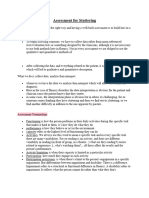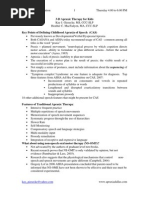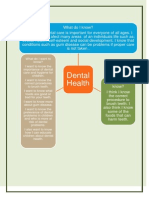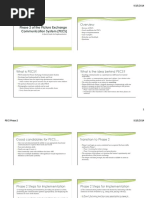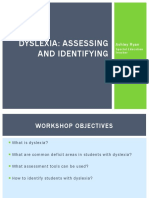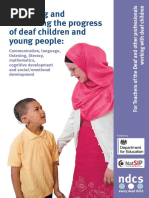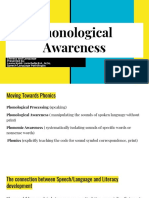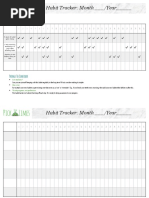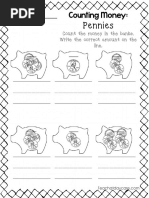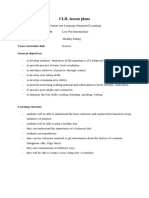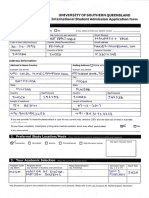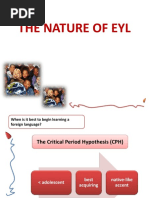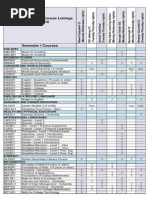Sifter PDF
Sifter PDF
Uploaded by
Ann VillablancaCopyright:
Available Formats
Sifter PDF
Sifter PDF
Uploaded by
Ann VillablancaOriginal Title
Copyright
Available Formats
Share this document
Did you find this document useful?
Is this content inappropriate?
Copyright:
Available Formats
Sifter PDF
Sifter PDF
Uploaded by
Ann VillablancaCopyright:
Available Formats
S.I.F.T.E.R.
SCREENING INSTRUMENT FOR TARGETING EDUCATIONAL RISK
by Karen L. Anderson, Ed.S., CCC-A
STUDENT ____________________________________ TEACHER ____________________ GRADE __________
DATE COMPLETED _____________ SCHOOL ________________________________ DISTRICT ____________
The above child is suspect for hearing problems which may or may not be affecting his/her school performance.
This rating scale has been designed to sift out students who are educationally at risk possibly as a result of hearing problems.
Based on your knowledge from observations of this student, circle the number best representing his/her behavior.
After answering the questions, please record any comments about the student in the space provided on the reverse side.
1. What is your estimate of the student's class standing in UPPER MIDDLE LOWER
comparison of that of his/her classmates? 5 4 3 2 1
ACADEMICS
2. How does the student's achievement compare to your estimation EQUAL LOWER MUCH LOWER
of her/her potential? 5 4 3 2 1
3. What is the student's reading level, reading ability group or UPPER MIDDLE LOWER
reading readiness group in the classroom (e.g., a student with 5 4 3 2 1
average reading ability performs in the middle group)?
4. How distractible is the student in comparison to his/her NOT VERY AVERAGE VERY
classmates? 5 4 3 2 1
ATTENTION
5. What is the student's attention span in comparison to that of his/ LONGER AVERAGE SHORTER
her classmates? 5 4 3 2 1
6. How often does the student hesitate or become confused when NEVER OCCASIONALLY FREQUENTLY
responding to oral directions (e.g., "Turn to page . . .")? 5 4 3 2 1
COMMUNICATION
7. How does the student's comprehension compare to the average ABOVE AVERAGE BELOW
understanding ability of her/her classmates? 5 4 3 2 1
8. How does the student's vocabulary and word usage skills ABOVE AVERAGE BELOW
compare with those of other student s in his/her age group? 5 4 3 2 1
9. How proficient is the student at telling a story or relating ABOVE AVERAGE BELOW
happenings from home when compared to classmates? 5 4 3 2 1
10. How often does the student volunteer information to class
PARTICIPATION
FREQUENTLY OCCASIONALLY NEVER
discussions or in answer to teacher questions? 5 4 3 2 1
CLASS
11. With what frequency does the student complete his/her class ALWAYS USUALLY SELDOM
and homework assignments within the time allocated? 5 4 3 2 1
12. After instruction, does the student have difficulty starting to NEVER OCCASIONALLY FREQUENTLY
work (looks at other students working or asks for help)? 5 4 3 2 1
13. Does the student demonstrate any behaviors that seem NEVER OCCASIONALLY FREQUENTLY
unusual or inappropriate when compared to other students? 5 4 3 2 1
BEHAVIOR
SCHOOL
14. Does the student become frustrated easily, sometimes to the NEVER OCCASIONALLY FREQUENTLY
point of losing emotional control? 5 4 3 2 1
15. In general, how would you rank the student's relationship GOOD AVERAGE POOR
with peers (ability to get along with others)? 5 4 3 2 1
Copyright ©1989 by Karen Anderson Author permission is granted for reproduction.
TEACHER COMMENTS
Has this child repeated a grade, had frequent absences or experienced health problems
(including ear infections and colds)? Has the student received, or is he/she now receiving,
special services? Does the child have any other health problems that may be pertinent to his/
her educational functioning?
The S.I.F.T.E.R. is a SCREENING TOOL ONLY
Any student failing this screening in a content area as determined on the scoring grid below should be
considered for further assessment, depending on his/her individual needs as per school district criteria. For
example, failing in the Academics area suggests an educational assessment, in the Communication area a
speech-language assessment, and in the School Behavior area an assessment by a psychologist or a social
worker. Failing in the Attention and/or Class Participation area in combination with other areas may suggest
an evaluation by an educational audiologist. Children placed in the marginal area are at risk for failing and
should be monitored or considered for assessment depending upon additional information.
SCORING
Sum the responses to the three questions in each content area and record in the appropriate box on the reverse
side and under Total Score below. Place an X on the number that corresponds most closely with the content
area score (e.g., if a teacher circled 3, 4 and 2 for the questions in the Academics area, an X would be placed
on the number 9 across from the Academics content area). Connect the X's to make a profile.
CONTENT AREA TOTAL PASS MARGINAL FAIL
SCORE
ACADEMICS 15 14 13 12 11 10 9 8 7 6 5 4 3
ATTENTION 15 14 13 12 11 10 9 8 7 6 5 4 3
COMMUNICATION 15 14 13 12 11 10 9 8 7 6 5 4 3
CLASS
PARTICIPATION 15 14 13 12 11 10 9 8 7 6 5 4 3
SOCIAL BEHAVIOR 15 14 13 12 11 10 9 8 7 6 5 4 3
You might also like
- Goal Bank For Auditory ProcessingDocument2 pagesGoal Bank For Auditory ProcessingAnn Villablanca86% (7)
- Cover Letter For BDMADocument2 pagesCover Letter For BDMAWeldemhret WelayNo ratings yet
- Speech Sounds - A Guide For Parents and Professionals PDFDocument48 pagesSpeech Sounds - A Guide For Parents and Professionals PDFAnn Villablanca100% (2)
- Aaa - Gfta Contract 2021-2026 Final 6-24-22Document69 pagesAaa - Gfta Contract 2021-2026 Final 6-24-22api-308625006No ratings yet
- Dworkin-Culatta Oral Mechanism Examination and Treatment SystemDocument2 pagesDworkin-Culatta Oral Mechanism Examination and Treatment Systemlogoioannina100% (1)
- Goal Bank For Social Skills and PragmaticsDocument3 pagesGoal Bank For Social Skills and PragmaticsAnn Villablanca100% (2)
- Goal Bank For ArticulationDocument2 pagesGoal Bank For ArticulationAnn Villablanca100% (4)
- Assessment For StutteringDocument8 pagesAssessment For StutteringFarah Allaik 1No ratings yet
- SOS APPROACH Explanation For ParentsDocument5 pagesSOS APPROACH Explanation For ParentsAnn Villablanca100% (3)
- Lesson 1: What, Why and How To Evaluate A Curriculum: Module 5: Evaluating The Curriculum Module OverviewDocument7 pagesLesson 1: What, Why and How To Evaluate A Curriculum: Module 5: Evaluating The Curriculum Module OverviewEdlord Moster80% (5)
- Giesecke, Kay - 3-D Apraxic Therapy For KidsDocument6 pagesGiesecke, Kay - 3-D Apraxic Therapy For KidsampiccaNo ratings yet
- Pediatric Feeding Template Liquid Pureed SolidDocument7 pagesPediatric Feeding Template Liquid Pureed SolidAlejandro BuitragoNo ratings yet
- Celf5 Final EssayDocument11 pagesCelf5 Final Essayapi-317403197100% (1)
- Goal Bank For Phonological Awareness and Auditory DiscriminationDocument1 pageGoal Bank For Phonological Awareness and Auditory DiscriminationAnn Villablanca100% (1)
- Communication Strategies ParDocument2 pagesCommunication Strategies Parapi-435363868No ratings yet
- Lesson 3: Initiating An Independent Communicative Exchange: Subject Teacher Grade DateDocument4 pagesLesson 3: Initiating An Independent Communicative Exchange: Subject Teacher Grade Dateapi-471223203No ratings yet
- Aselmes 11450578 A 3Document38 pagesAselmes 11450578 A 3api-251180024No ratings yet
- Week 3-Phase 2 of The Picture Exchange Communication System SlidesDocument4 pagesWeek 3-Phase 2 of The Picture Exchange Communication System Slidesapi-338683366No ratings yet
- Sanatate KineticaDocument14 pagesSanatate KineticacrinaconstantNo ratings yet
- GAG ReflexDocument4 pagesGAG Reflexdrgayen6042No ratings yet
- Parent Questionnaire (Speech)Document4 pagesParent Questionnaire (Speech)Khairul Zainizah KhairudinNo ratings yet
- Swallowing and DysphagiaDocument25 pagesSwallowing and DysphagiaFernanda BecerraNo ratings yet
- Module 2A Introduction To Motor Based Assessment HandoutDocument20 pagesModule 2A Introduction To Motor Based Assessment HandoutJohanna Steffie Arun KumarNo ratings yet
- Abbreviated Profile of Hearing Aid BenefitDocument4 pagesAbbreviated Profile of Hearing Aid BenefitAnn VillablancaNo ratings yet
- The Use of Play Assessment To Evaluate The Cognitive Skills of TWDocument15 pagesThe Use of Play Assessment To Evaluate The Cognitive Skills of TWIkmal FirdausNo ratings yet
- SLP Diagnostic Review ManualDocument166 pagesSLP Diagnostic Review ManualmaddieheydonNo ratings yet
- THEORETICAL PERSPECTIVES IN CLUTTERING, FAST RATE OF SPEECH - PDF / KUNNAMPALLIL GEJO JOHNDocument102 pagesTHEORETICAL PERSPECTIVES IN CLUTTERING, FAST RATE OF SPEECH - PDF / KUNNAMPALLIL GEJO JOHNKUNNAMPALLIL GEJO JOHNNo ratings yet
- Langearly14 Language Stimulation TechniquesDocument50 pagesLangearly14 Language Stimulation Techniquesapi-337162869No ratings yet
- Post Stroke WritingDocument9 pagesPost Stroke WritingAdi ParamarthaNo ratings yet
- Palin Parent-Child Interaction Therapy: What Does The Research Tell Us About Why Children Stutter?Document13 pagesPalin Parent-Child Interaction Therapy: What Does The Research Tell Us About Why Children Stutter?Betül Özsoy TanrıkuluNo ratings yet
- Stimulus Characteristics of Single-Word Tests of Children 'S Speech Sound ProductionDocument16 pagesStimulus Characteristics of Single-Word Tests of Children 'S Speech Sound ProductionCourteney McclutchyNo ratings yet
- ApproachesDocument3 pagesApproachesDaisy xoNo ratings yet
- West (2005) - Interventions For Apraxia of Speech Following Stroke)Document14 pagesWest (2005) - Interventions For Apraxia of Speech Following Stroke)ConnieSwiftNo ratings yet
- Cluttering and Stuttering EbookDocument2 pagesCluttering and Stuttering EbookPrakash ThakurNo ratings yet
- Cognitive Linguistic Assessment Protocol For Adults - Kannada Clap-KDocument47 pagesCognitive Linguistic Assessment Protocol For Adults - Kannada Clap-KSureaka PonnusamyNo ratings yet
- VC VC VC VC: Click On Your Question:cDocument10 pagesVC VC VC VC: Click On Your Question:cNurul IqasNo ratings yet
- Sydney Swallow Questionnaire: Name: - DOB/Sex: - DateDocument4 pagesSydney Swallow Questionnaire: Name: - DOB/Sex: - DateLADY MARIAN CASTAÑEDA MARANTA100% (1)
- What Is Auditory Verbal Therapy Cochlear ImplantDocument27 pagesWhat Is Auditory Verbal Therapy Cochlear ImplantMariangela MontoyaNo ratings yet
- ORLADocument10 pagesORLACarol CoelhoNo ratings yet
- Dyslexia WorkshopDocument22 pagesDyslexia Workshopapi-350289078No ratings yet
- Sensory Motor PyramidDocument1 pageSensory Motor Pyramidcirclestretch100% (1)
- NDCS NatSIP DfE Assessments Booklet Final 2nd EditionDocument174 pagesNDCS NatSIP DfE Assessments Booklet Final 2nd EditionAlina IlievNo ratings yet
- Baker 2012 Optimal Intervention IntensityDocument10 pagesBaker 2012 Optimal Intervention IntensityWingYan LiuNo ratings yet
- Learning StrategiesDocument18 pagesLearning StrategiesLizamaria Raphael ParrikalNo ratings yet
- Phonological AwarenessDocument15 pagesPhonological Awarenessapi-543388599No ratings yet
- Dysphagia Handicap Index, Development and ValidationDocument7 pagesDysphagia Handicap Index, Development and ValidationWlf OoNo ratings yet
- Assesment of StutteringDocument12 pagesAssesment of StutteringASMAA NOORUDHEENNo ratings yet
- Immediate Download Autism Spectrum Disorders 1st Edition David Amaral Ebooks 2024Document84 pagesImmediate Download Autism Spectrum Disorders 1st Edition David Amaral Ebooks 2024miirnyrlan68100% (2)
- Oral Habits Part2 Beyond5Document8 pagesOral Habits Part2 Beyond5PhanQuangHuyNo ratings yet
- Habit Tracker - Pick Up LimesDocument2 pagesHabit Tracker - Pick Up LimesAmeya Joshi100% (1)
- Summers Et Al., 2008b What Impact Does Developmental Coordination Disorder Have On Daily RoutinesDocument12 pagesSummers Et Al., 2008b What Impact Does Developmental Coordination Disorder Have On Daily RoutinesCharitini PetridouNo ratings yet
- Osce SpeechDocument3 pagesOsce SpeechKai JieNo ratings yet
- Western Aphasia Battery-Revised Profiles in Primary Progressive Aphasia and Primary Progressive Apraxia of SpeechDocument13 pagesWestern Aphasia Battery-Revised Profiles in Primary Progressive Aphasia and Primary Progressive Apraxia of SpeechElena Medina EspinozaNo ratings yet
- Wernicke Aphasia LecDocument39 pagesWernicke Aphasia Lecaleeza nomanNo ratings yet
- Broca Aphasia Sign Symptom2020Document23 pagesBroca Aphasia Sign Symptom2020aleeza nomanNo ratings yet
- Telepractice Results With High-Risk Preschoolers Using A Web-Based ApproachDocument99 pagesTelepractice Results With High-Risk Preschoolers Using A Web-Based ApproachNathan Curtis100% (1)
- Lit BrochureDocument3 pagesLit Brochureapi-302650939No ratings yet
- Articulation Test Centre (ATC) - Full Test or Screener - TemplateDocument2 pagesArticulation Test Centre (ATC) - Full Test or Screener - TemplateJershon YongNo ratings yet
- Classification of Velopharyngeal DysfunctionDocument1 pageClassification of Velopharyngeal DysfunctionVictoria Rojas AlvearNo ratings yet
- PLS-5 - Speech and Language 2Document49 pagesPLS-5 - Speech and Language 2claudia100% (1)
- Pediatric Stuttering Assessment TemplateDocument8 pagesPediatric Stuttering Assessment Templateirum nawazNo ratings yet
- Transactional Writing Help SheetDocument2 pagesTransactional Writing Help SheetannekeNo ratings yet
- Small Talk ReportDocument98 pagesSmall Talk ReportAdnanNo ratings yet
- Discrete Trial TeachingDocument2 pagesDiscrete Trial TeachingsuisenNo ratings yet
- Dysphagia Management of Pediatric Patients With Cerebral PalsyDocument17 pagesDysphagia Management of Pediatric Patients With Cerebral PalsyDaniela AdarosNo ratings yet
- Edu 532 - Day 8Document9 pagesEdu 532 - Day 8Mhel Angel Bautista BulawitNo ratings yet
- Hyper-Salivation, A Simple Guide To The Condition, Diagnosis, Treatment And Related ConditionsFrom EverandHyper-Salivation, A Simple Guide To The Condition, Diagnosis, Treatment And Related ConditionsNo ratings yet
- Dice Domino Build and Write It Place ValueDocument10 pagesDice Domino Build and Write It Place ValueAnn VillablancaNo ratings yet
- Counting Money WorksheetsDocument10 pagesCounting Money WorksheetsAnn VillablancaNo ratings yet
- March April TSC 2023 LRDocument20 pagesMarch April TSC 2023 LRAnn VillablancaNo ratings yet
- LogDocument4 pagesLogAnn VillablancaNo ratings yet
- Let - S SummarizeDocument1 pageLet - S SummarizeAnn VillablancaNo ratings yet
- Goal Bank For FluencyDocument2 pagesGoal Bank For FluencyAnn Villablanca100% (3)
- All About Shapes WorksheetsDocument10 pagesAll About Shapes WorksheetsAnn VillablancaNo ratings yet
- FunctionalPlayChecklist PDFDocument2 pagesFunctionalPlayChecklist PDFAnn VillablancaNo ratings yet
- Addition PDFDocument22 pagesAddition PDFAnn VillablancaNo ratings yet
- Tribest Hot Sale Items Price List-202023Document12 pagesTribest Hot Sale Items Price List-202023Ann VillablancaNo ratings yet
- Abbreviated Profile of Hearing Aid BenefitDocument4 pagesAbbreviated Profile of Hearing Aid BenefitAnn VillablancaNo ratings yet
- Manual Coffee Depulper: Transforming The Future of AgricultureDocument1 pageManual Coffee Depulper: Transforming The Future of AgricultureAnn VillablancaNo ratings yet
- Academic ToolkitDocument23 pagesAcademic ToolkitAnn VillablancaNo ratings yet
- Assessment of Speech - Sound Production PDFDocument50 pagesAssessment of Speech - Sound Production PDFAnn VillablancaNo ratings yet
- Driving EvaluationDocument43 pagesDriving EvaluationAnn VillablancaNo ratings yet
- Self Efficacy QuestionnaireDocument10 pagesSelf Efficacy QuestionnaireElia Kim FababeirNo ratings yet
- Educational Technology & Education Conferences #39, June To December 2018, Clayton R. WrightDocument131 pagesEducational Technology & Education Conferences #39, June To December 2018, Clayton R. WrightcrwrNo ratings yet
- Practical ResearchDocument37 pagesPractical ResearchVinz Canoza100% (1)
- Loweryk Lessonplan Banned Books WekDocument2 pagesLoweryk Lessonplan Banned Books Wekapi-632517517No ratings yet
- CV 2023Document4 pagesCV 2023Deslegn ArgetaNo ratings yet
- The Role of The Mother Tongue in EFL Classrooms.: John HolthouseDocument12 pagesThe Role of The Mother Tongue in EFL Classrooms.: John HolthouseStefanNo ratings yet
- Executive Coaching Enhances Goal Attainment, Resilience and ELIMINADO PDFDocument13 pagesExecutive Coaching Enhances Goal Attainment, Resilience and ELIMINADO PDFjsanmartincavNo ratings yet
- MELCHOR BANIAGA Reflection 2 Economics of EducationDocument3 pagesMELCHOR BANIAGA Reflection 2 Economics of EducationMelchor BaniagaNo ratings yet
- Imprimir Clil Lesson PlansDocument5 pagesImprimir Clil Lesson PlansLorena Vega LimonNo ratings yet
- Manpreet Kaur USQ Application FormDocument5 pagesManpreet Kaur USQ Application FormGagandeep KaurNo ratings yet
- 004 September 5, 2023 ARTS Q1 W1aDocument3 pages004 September 5, 2023 ARTS Q1 W1aJullene TunguiaNo ratings yet
- Evaluation of This Document Is Needed Every Year: A. Details of CourseDocument17 pagesEvaluation of This Document Is Needed Every Year: A. Details of CourseStephani Dwiyana PutriNo ratings yet
- Lesson 1 - Spin The WheelDocument3 pagesLesson 1 - Spin The Wheelapi-335773558No ratings yet
- THE NATURE OF EYL - For Students PDFDocument27 pagesTHE NATURE OF EYL - For Students PDFveraNo ratings yet
- Aim of The Subject: Learning StrategiesDocument13 pagesAim of The Subject: Learning StrategiesMCFNo ratings yet
- Heidenreich Kaeli - Resume SeptDocument1 pageHeidenreich Kaeli - Resume Septapi-425879330No ratings yet
- LO1 Tools in EmbroideryDocument5 pagesLO1 Tools in EmbroideryKrizza BarongNo ratings yet
- DLL HEALTH 8, Week 1, Quarter 1Document3 pagesDLL HEALTH 8, Week 1, Quarter 1chadie marge morataNo ratings yet
- Sample AnnotationDocument21 pagesSample AnnotationAmy Balasan86% (7)
- 03-02 Lesson PlanDocument8 pages03-02 Lesson PlanDean WinchesterNo ratings yet
- Lesson Plan Cot - EvolutionDocument4 pagesLesson Plan Cot - EvolutionJinky TabigneNo ratings yet
- Therese Angelu L. Abion: Bicol College, Cor. JP Rizal and Tabuena Streets, Daraga, AlbayDocument2 pagesTherese Angelu L. Abion: Bicol College, Cor. JP Rizal and Tabuena Streets, Daraga, AlbaySESENo ratings yet
- Priscilla Gutierrez Richard Curwin and Allen MendlerDocument10 pagesPriscilla Gutierrez Richard Curwin and Allen Mendlerapi-287190140No ratings yet
- School Facilities Improvement Plan: Guiding PrinciplesDocument3 pagesSchool Facilities Improvement Plan: Guiding PrinciplesMarcelo SakitingNo ratings yet
- 10a. TYPES OF PORTFOLIODocument17 pages10a. TYPES OF PORTFOLIOreeyu lalalalaNo ratings yet
- DAILY-LESSON-LOG-BLANK-MATATAG-FORMATDocument2 pagesDAILY-LESSON-LOG-BLANK-MATATAG-FORMATjennylou.minervaNo ratings yet
- TDSB Night School Course Listings - Semester 1 2015-16Document2 pagesTDSB Night School Course Listings - Semester 1 2015-16Karen KrisfalusiNo ratings yet
- Saguid Final Demo Grade 10Document5 pagesSaguid Final Demo Grade 10Angelou LeanilloNo ratings yet







